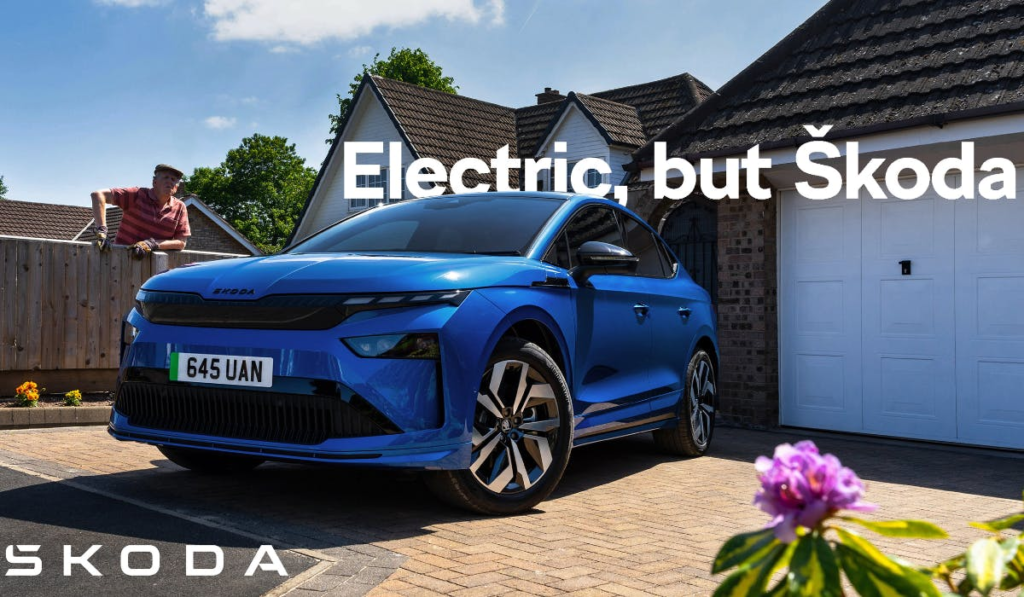 The EV market in the UK is growing, but the average British driver is still hesitant to make the switch.
The EV market in the UK is growing, but the average British driver is still hesitant to make the switch.
Just under a quarter of prospective car buyers are considering EVs (23%) over the next 12 months, according to YouGov Profiles data, compared to 70% who still favour petrol-powered vehicles. For most, it’s due to concerns over high up front cost (60%) and the lack of availability of charging stations (44%).
This is where Skoda’s ‘Electric, but Skoda’ comes in. The campaign aims to poke fun at the stereotypes surrounding EV drivers – the ‘tech bros’, the ‘hipsters’, and the ‘tree huggers’ – to assert that switching to EVs is something for everyone.
 The EV market in the UK is growing, but the average British driver is still hesitant to make the switch.
The EV market in the UK is growing, but the average British driver is still hesitant to make the switch.
Just under a quarter of prospective car buyers are considering EVs (23%) over the next 12 months, according to YouGov Profiles data, compared to 70% who still favour petrol-powered vehicles. For most, it’s due to concerns over high up front cost (60%) and the lack of availability of charging stations (44%).
This is where Skoda’s ‘Electric, but Skoda’ comes in. The campaign aims to poke fun at the stereotypes surrounding EV drivers – the ‘tech bros’, the ‘hipsters’, and the ‘tree huggers’ – to assert that switching to EVs is something for everyone.
Rather than targeting those who are already considering an electric vehicle, Skoda is aiming to attract people who are undecided about switching to a different type of vehicle.
Spanning TV, cinema, social and digital, education is therefore a major part of the campaign as the brand looks to allay any concerns prospective customers might have.
“We looked at what people are saying on social media, what questions are coming up in the chat on our website, and we also spoke to our salespeople to find out our prospective customers’ concerns,” Skoda’s UK marketing director, Kirsten Stagg tells Marketing Week.
“They’re worried about range. Also, people don’t really understand how cost-effective it can be to drive an electric car, particularly if you’re charging it at home and charging it overnight.”
To help answer some of these fears, the car marque has also launched Ask Skoda, a companion series of social content, where characters from the longer-form ad ask these basic questions and get a simple response.
“No question is too daft and we can help you,” she affirms.
Skoda was able to access a great deal of data on the buying behaviour of those considering purchasing an EV, without having to do bespoke research just for this campaign, Stagg adds.
“We have customer panels, so we had lots of insight from customers and prospects that we’ve spoken to about electric vehicles, but also there was a great deal of industry research we could pull from,” she explains.
This meant the marketing team was able to access and understand the concerns of someone who is unsure about purchasing an EV over a petrol engine.
From leads to conversions
While the majority of the ad spend is going on the cinema and TV spots, Skoda is looking to engage more people in real life by getting them into showrooms.
“Our core call to action on the website is to speak to a retailer, because ultimately we just want to encourage people to come and talk to us,” she adds.
The digital and social elements are designed to reassure customers of their concerns, but also keep them engaged with the campaign. This involves retargeting and following up with customers who have engaged with the content.
Ultimately we just want to encourage people to come and talk to us.
Kirsten Stagg, Skoda UK
This campaign marks somewhat of a departure from previous Skoda campaigns around EVs, since it historically embraced a tech-focused approach as seen in its campaign for the Enyaq Coupé iV two years ago.
“It’s the first time we’ve had a really customer-centric campaign. Up until now, we’ve focused on how we launch our cars and tell the story of what the cars do,” Stagg explains.
“What we learned from the product-led approach is that it was successful for us with this earlier adopter audience,” she continued. However, since this campaign is targeting a different area of the market, a different strategy was needed.
“Whereas now it’s more about mindset around EVs in general,” so product specifications are less of a priority in that regard.
To that end, she says: “We really saw the opportunity as linking so closely into how customers feel, so that was our starting point.”
‘It’s a pivotal moment’: Skoda targets new customers with electric push
Long-term success
While the campaign aims to assert the fact that purchasing an EV is no different from purchasing a combustion engine vehicle, Stagg explains this campaign has a different objective from a typical campaign for the brand.
“It can take two months, three months – as opposed to a month – so we just want to make sure that we’re not losing those people and we keep up the engagement with them,” she says, referring to the digital aspect of the campaign.
Although Skoda has a sales target in mind, as the sales cycle is typically longer with EVs, Stagg says there are other things it must consider.
“We’re also looking at the volume of contact that we can initiate through speaking to a retailer,” she says. But the most important measure of success, according to Stagg, is wanting to “position ourselves as a brand [to ensure it’s front of mind] so that when [people] then come to electric, they want to come to us”.


